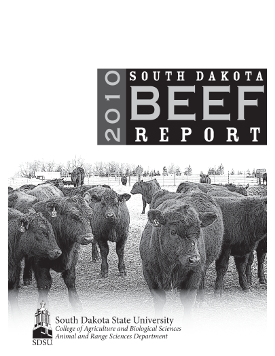Document Type
Report
Report Number
2010-9
Publication Date
2010
Summary
Beef steers (n = 72) of similar age, weight (651 ± 3.1 lb), and genetic (Angus crossbred) background were used to determine the effects of growing diet composition (high‐forage vs. high‐concentrate) on the abundance of growth hormone secretagogue receptor (GHS‐R or ghrelin receptor) in metabolically important tissues of beef cattle. At trial initiation (d 0), 8 steers were harvested for initial carcass composition. The remaining 64 steers were allotted, by weight, to pen and treatment was assigned randomly. Treatments were 1) a high‐forage diet fed during the growing period (116 d) followed by a high‐concentrate diet during the finishing period (117‐209 d; GRW‐FNSH) or 2) a high‐concentrate diet fed for the duration of the trial (0‐209 d; FNSH‐FNSH). Steers were allowed ad libitum consumption regardless of dietary treatment. Eight steers per treatment were harvested on d 88, 116, 165, and 209. Immediately following harvest, liver, muscle (sternomandibularis), and subcutaneous adipose tissue samples were collected from each steer and immersed in liquid nitrogen. Longissimus dorsi samples were collected following a 48 h chill to establish a preliminary analysis of GHS‐R abundance within an economically important muscle tissue. Protein separation and quantification was determined using SDSPAGE and Western blotting techniques. Protein abundance was detected using the LI‐COR® system and standardized to β‐Actin. Protein abundance data were analyzed statistically using the GLM procedure of SAS comparing diet, harvest date, and their interaction. Protein abundance of GHS‐R in longissimus dorsi tissue fluctuated relative to serial harvest date (P < 0.001), and was highest on d 88 in both treatment groups. The FNSH‐FNSH steers had increased abundance of GHS‐R in longissimus dorsi on d 88 and 116 compared with the GRW‐FNSH steers. A dietary treatment by serial harvest day interaction (P < 0.05) occurred for protein abundance of GHS‐R in subcutaneous adipose tissue. Abundance of GHS‐R in subcutaneous adipose tissue of the GRW‐FNSH was greatest on d 88, whereas abundance for the FNSHFNSH treatment was greatest at the end of the finishing period (d 209). An interaction of dietary treatment and serial harvest day resulted (P < 0.05) for GHS‐R abundance in liver tissue. The GRW‐FNSH steers had increased liver GHS‐R abundance following realimentation compared with the FNSH‐FNSH steers which were on a continuous plane of nutrition. Protein abundance for liver GHS‐R in both dietary treatments increased quadraticly (P < 0.001) throughout the feeding period. The GHS‐R was not detected in sternomandibularis tissue. Overall liver GHS‐R abundance increased in both dietary treatments following realimentation which is inconsistent with our hypothesis. Increased GHS‐R abundance in various tissues of beef cattle while ghrelin concentrations are high and excess fat deposition is occurring warrants further investigation.
Number of Pages
8
Format
application/pdf
Language
en
Publisher
South Dakota State University
Rights
Copyright © 2010 South Dakota State University.
Recommended Citation
Jennings, J.S.; Clapper, J.A.; Weaver, A.D.; and Wertz-Lutz, A.E., "The Presence of Growth Hormone Secretagogue Receptor (ghrelin receptor) in
Metabolic Tissues of Beef Cattle with Differences in Composition of Gain" (2010). South Dakota Beef Report, 2010. 10.
https://openprairie.sdstate.edu/sd_beefreport_2010/10

